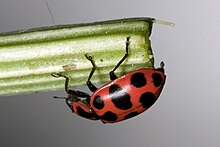Coleomegilla maculata
| Coleomegilla maculata | |
|---|---|
 |
|
| C. maculata on stem | |
| Scientific classification | |
| Kingdom: | Animalia |
| Phylum: | Arthropoda |
| Class: | Insecta |
| Order: | Coleoptera |
| Family: | Coccinellidae |
| Genus: | Coleomegilla |
| Species: | C. maculata |
| Binomial name | |
|
Coleomegilla maculata De Geer, 1775 |
|
Coleomegilla maculata, commonly known as the spotted lady beetle, pink spotted lady beetle or twelve-spotted lady beetle, is a large coccinellid beetle native to North America. The adults and larvae feed primarily on aphids and the species has been used as a biological control agent. Based on name connotation and to avoid confusion with other species also called "spotted ladybeetle", spotted pink ladybeetle is probably the most appropriate common name for this species.
This is generally an oblong, flattened lady beetle species averaging about six millimetres long. Over most of its range the species is pink in coloration, except for subspecies fuscilabris which is bright orange or red. Each wing cover features 6 black markings. The thorax is a similar shade of red with two large triangular black patches. Similarity is most apparent with the seaside lady beetle, but that species is limited to coastal habitats and features much larger black markings. In that species the apical pair of spots on the elytra as well as the pronotum markings are merged, unlike Coleomegilla maculata.
The larvae resemble miniature alligators and are dark coloured. They have three pairs of legs and grow to about six millimetres long. The eggs are spindle shaped and laid upright in groups near potential prey.
A female beetle may lay between 200 and 1,000 eggs in groups of 8-15 in protected sites on stems and leaves over a three-month period. The larvae actively seek out prey and may travel as far as twelve metres in their search for food. The larvae grow rapidly, moulting four times before attaching themselves by the abdomen to a leaf or other surface to pupate. The adult beetles emerge from three to twelve days later depending on the temperature. There are two to five generations per year. This species is most abundant in September when they congregate before mating and winter hibernation. They overwinter in large aggregations in leaf litter, under stones and in other protected sites at the edge of fields and hedgerows. They emerge in spring and look for suitable prey and egg laying sites in nearby crops, often dispersing by walking along the ground.
...
Wikipedia
